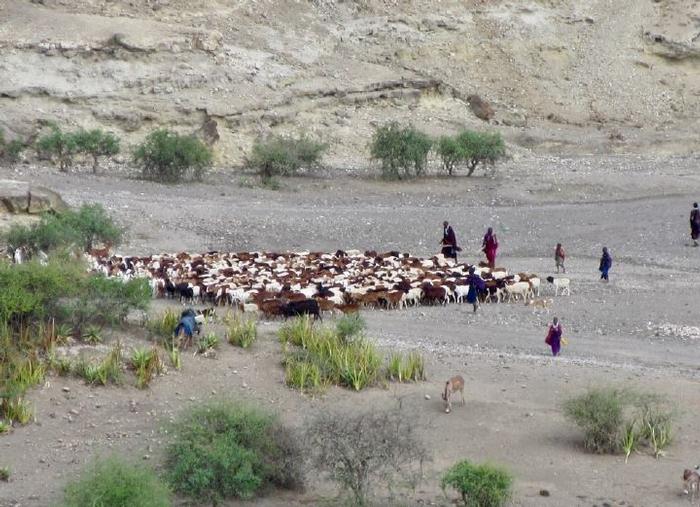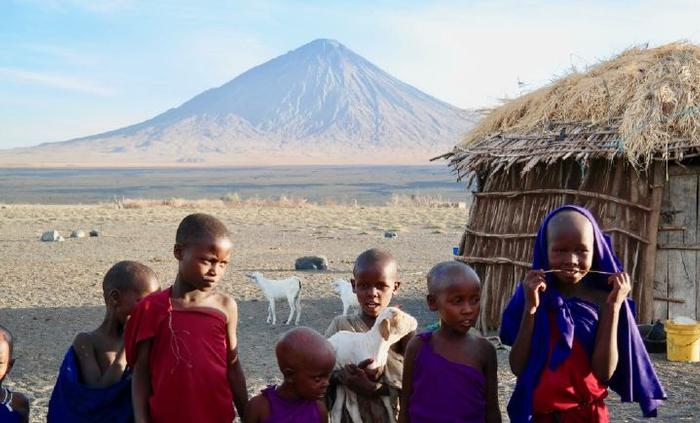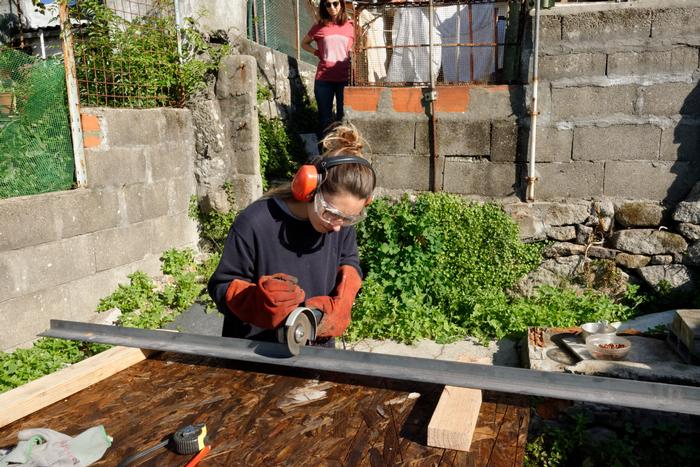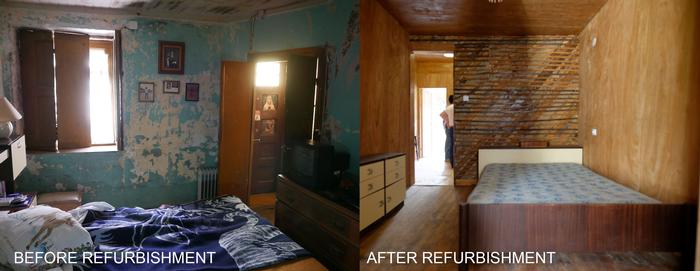Aarushi Sharma Travel ProposalIn Pursuit of KnowledgeBUILDING FOR LEARNING: Life Skills for the Maasai of Tanzania Imagine. Flamingos. Rose pink, peachy orange and ivory white- in a congregational affair, having a celebration of their own, sifting the salt waters for algae on the shores of Lake Natron- the simple act of gathering food translated into a riotously colourful image of beauty. Imagine. The greatness of the oldest trace of human existence, manifest in the 120,000 years old human footprints that attract intellectuals from world-wide. Now, imagine this. Long sultry summer, parched desert landscape, dry mouths and perspiration on the glistening skins, humans in crimson attire, traveling in search of green pastures for cattle; foraging far and wide into the unforgiving difficult horizons, only to return home when summer passes. The marvels of Arusha region in northern Tanzania, Africa are not just limited to natural phenomena. It boasts of the peculiar Maasai Warrior tribes, distinguished by its intricate ornaments, bright clothing and age-old rituals that defy contemporary beliefs. A nomadic ethnic group that is a victim of the indigenous vs. modern debate- giving birth to insecurities, confusion and a ‘threatened identity’. Call it an occupational-hazard, the children of the tribe have to move with their parents to far places, unable to reach schools, leading to discontinued education and lost time. Thus, the Maasai children altogether lack the basic skills to prosper in the African society, this confines their interaction within their own community. The conventional English Medium schools are no help in bridging this gap. Such schools are repulsive to tribal kids as they are regarded as a symbol of disconnection between the local knowledge system and the modern values. In another gravely disconcerting situation, the children from a young age are exposed to foreigners in their flashy expensive clothes, where the tribal act as objects of recreation for the tourists. Such irresponsible flamboyance makes the children insecure and doubtful about their own tradition and cultural values. The ‘Esupat Centre for Cultural Diversity’ is a not-for-profit organisation based in Arusha, which runs the ‘Esupat Education Program’ in the region to bring coherence between traditional Maasai life and the modern African schooling system. ‘Esupat’ is a Maasai name which means ‘the one who cares for others’. The Maasai elders, on mutual decision, agreed upon the importance of the education program, and, donated 10 acres of land at Lake Natron, to the organisation. The education program has proposed the Esupat School and Cultural Centre. The design program comprises construction of three School blocks that have three classrooms each, combined with three Hostel blocks with two dormitories each, simple housing for teachers , and the Maasai Cultural and Visitors Centre with bathrooms, kitchen facilities, and a tented campsite. The organisation requires an Architecture volunteer to carry out the architectural work on the school building- design, planning, architectural drawings and so on. The first leg of my fellowship is to work on the school as a volunteer for four weeks in July, in the event of winning this award. My application has been accepted by the organisation. I firmly believe in the notion: “All cultural diversity of mankind must be preserved as a world heritage, in a similar way as we need to preserve biodiversity.” The tribal are held together by their beliefs and values. I understand the situation deeply, because I have faced similar challenges during research on my final year design thesis project this semester. It is a school for tribal children of Sehore district of Madhya Pradesh in India. The predominant tribes at the site are inherently reclusive. Their interface with modern technology is negligible. An education facility in this situation is faced with fundamental questions: Why should parents send their kids to school when they can serve as extra hands at work? Should students learn conventional subjects and not their indigenous knowledge? How can the gap be bridged? While I’m working on design solutions for my thesis, working hands-on in Tanzania shall provide me primary insight into the process of working for and with the people. I intend to observe the traditional knowledge system of the Maasai and their habitat to bring forward the best design possibilities for them to flower. ILHAS: Breathing Life to the Archetype Home of the Industrial Revolution Era in Portugal “You take delight not in a city's seven or seventy wonders, but in the answer it gives to a question of yours.” ? Italo Calvino, Invisible Cities “Dilapidated stone-lined outer walls, damp decaying wooden partitions for interior walls, no doors- curtains, and stench seeping into crammed hallways – this is Ilhas for you.”- from a report on Ilhas- the ‘island houses’ of Porto city of Portugal. Ilhas is an evidence of planning efforts gone haywire, in the history of Porto, but arguably a remarkable and functioning (till date) example of social housing from the mid-nineteenth century. These houses stand as a symbol of the socio-economic scene after the Civil War, even as the population increased exponentially during the industrial revolution. These ‘working-class houses’ proved to be an inexpensive solution to the population explosion, not to mention the unhealthy living conditions which the residents accepted to call a home. The lower-middle class population was displaced into these houses located on the outskirts of the city, to decongest the city cores. Today, the Ilhas are a breathing legacy that testifies the brutalities of time. Unperturbed by the various bans imposed on these houses, they are still in use, in their rickety condition, and poor ventilation and light- in the poorest parts of the city of Porto. These houses are archetypal examples of regional improvisation; each plot frontage is 5.5 m whereas depth is 100m or more. Upon entrance, a major area is taken up by owner’s residence, the rest of the area in divided into rooms of area 15 sq.m. each, which open to a common linear pathway. Toilets are common. While there is no scope of intimacy or private space, the semi-private areas of Ilhas do generate a sense of mutual care among its inhabitants. The Ilhas function as a place of urban integration for newcomers who live close to older residents. The Summer School Programme- Practice & Theory of Sustainable and Social Architecture by ‘Critical Concrete’, in Porto, promotes social architecture through hands-on learning experiences in participation with underprivileged families of Porto. Each year, the oganisation gathers forty volunteers across the globe to work on Porto’s Ilhas houses, public buildings and urban public spaces. This year’s work will include demolition/refurbishing/rebuilding a typical Ilhas house, through an intensive participatory design and construction process involving volunteers. The program duration is three weeks in the month of August. Critical Concrete fosters the use of sustainable solutions and the re-use of discarded materials in building process to implement strong and repairable construction solutions. Thus, the second leg of my journey is an opportunity to work along with a culturally diverse team, learn about the spatial pattern of this typical house to understand what keeps it alive despite much criticism, and gain practical immersive experience. The biggest incentive is the joy of bringing to life the work of my hands, for a family in need. JOURNEY: The itinerary has been planned in two phases for exposure to two varying cultures, gain knowledge on how to approach indigenous challenges, and observe the impact of community and time in two varied economic, social and geographic contexts. The above will prove to be a groundwork for further research on peculiar cases of communities in India, which will help me to write a paper about my overall analysis. Since I’m in my final year of B. Arch., I shall graduate this June. It is a golden opportunity for me to travel and ponder on future possibilities, and to live with compassion and courage to be the change I want to see. ITENERARY: Phase1 (four weeks) – 1) Reach Kilimanjaro International Airport, Tanzania from Delhi on 29th July 2017- 590$ (Etihad Airways); 2) Stay at Backpacker’s Hostel for one month in Arusha during volunteer work- 450$; 3) Food for one month @ 10$ per day- 300$; 4) Local commute- 100$; 5) Other personal expenses to be borne by myself Phase2 (three plus one weeks) – 1) Reach Porto from Kilimanjaro International Airport, Tanzania on 4th August, 2017 – 890$ (Ethiopian Airlines); 2) Stay at @15$per night, three weeks during summer school- $400; 3) Leave for Lisbon to see local architecture on 30th August, 2017- 45$ (Ryanair); 4) Stay for five days @15$- 75$; 5) Food for one month @ 10$ per day- 300$; 6) Local commute- 100$; 7) Return from Lisbon to Delhi on 6th September, 2017- 462$ (Etihad Airways) 8) Other personal expenses to be borne by myself Total=3,712 $ *Rates as on 11th March, 2017, subject to change at the time of booking; any extra expenses above 3700$ will be borne by myself. References – 1) Mosses Ndiyaine, Ngorongoro Crater, Tanzania ndiyaine@gmail.com Secretary, Esupat Education Program 2) Ar. Manjusha Misra, Iran Manjusha.misra@gmail.com Former teacher, got me in touch with Mr. Mosses 3) Julliana Trentin mail@criticalconcrete.com http://criticalconcrete.com/summer-camp/programme/ Programme coordinator, Criticla Concrete, Porto, Portugal 4) Ar. Saurabh Popli popli.saurabh@spabhopal.ac.in Associate Professor at S.P.A. Bhopal, Mentor
Additional Help and InformationAre you in need of assistance? Please email info@berkeleyprize.org. |




